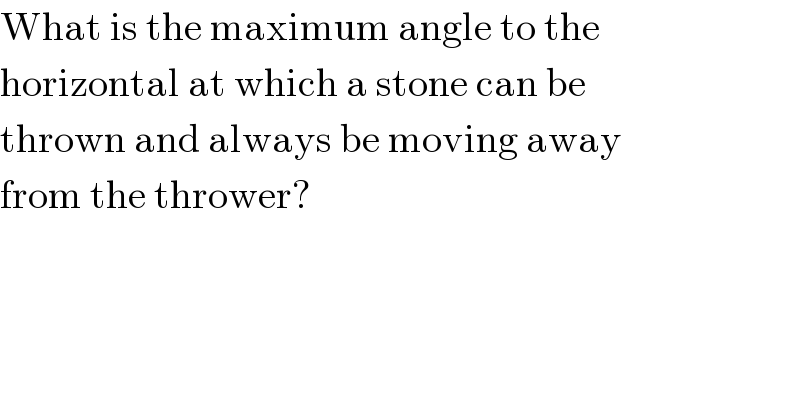
Question Number 18261 by Tinkutara last updated on 17/Jul/17

$$\mathrm{What}\:\mathrm{is}\:\mathrm{the}\:\mathrm{maximum}\:\mathrm{angle}\:\mathrm{to}\:\mathrm{the} \\ $$$$\mathrm{horizontal}\:\mathrm{at}\:\mathrm{which}\:\mathrm{a}\:\mathrm{stone}\:\mathrm{can}\:\mathrm{be} \\ $$$$\mathrm{thrown}\:\mathrm{and}\:\mathrm{always}\:\mathrm{be}\:\mathrm{moving}\:\mathrm{away} \\ $$$$\mathrm{from}\:\mathrm{the}\:\mathrm{thrower}? \\ $$
Answered by ajfour last updated on 26/Jul/17
![r=(√(x^2 +y^2 )) , x=u_x t , y=u_y t−((gt^2 )/2) (dr/dt)=(((((2xdx)/dt)+((2ydy)/dt)))/(2(√(x^2 +y^2 )))) =((u_x ^2 t+(u_y t−((gt^2 )/2))(u_y −gt))/(1(√(x^2 +y^2 )))) tan θ=(u_y /u_x ) (dr/dt)>0 ⇒t[u_x ^2 +(u_y −((gt)/2))(u_y −gt)]>0 or ((g^2 t^2 )/2)−((3u_y gt)/2)+u_x ^2 +u_y ^2 >0 ⇒ D=((9u_y ^2 g^2 )/4)−2g^2 (u_x ^2 +u_y ^2 ) < 0 ⇒ (u_y /(√(u_x ^2 +u_y ^2 ))) < ((2(√2))/3) or (u_y /u) < ((2(√2))/3) ⇒ sin θ < ((2(√2))/3) tan θ < 2(√2) cos θ > (1/3) θ < cos^(−1) (1/3) which is same as θ < tan^(−1) (2(√2)) .](Q18297.png)
$$\mathrm{r}=\sqrt{\mathrm{x}^{\mathrm{2}} +\mathrm{y}^{\mathrm{2}} }\:\:\:,\:\:\mathrm{x}=\mathrm{u}_{\mathrm{x}} \mathrm{t}\:,\:\:\:\mathrm{y}=\mathrm{u}_{\mathrm{y}} \mathrm{t}−\frac{\mathrm{gt}^{\mathrm{2}} }{\mathrm{2}} \\ $$$$\frac{\mathrm{dr}}{\mathrm{dt}}=\frac{\left(\frac{\mathrm{2xdx}}{\mathrm{dt}}+\frac{\mathrm{2ydy}}{\mathrm{dt}}\right)}{\mathrm{2}\sqrt{\mathrm{x}^{\mathrm{2}} +\mathrm{y}^{\mathrm{2}} }} \\ $$$$\:\:\:\:=\frac{\mathrm{u}_{\mathrm{x}} ^{\mathrm{2}} \mathrm{t}+\left(\mathrm{u}_{\mathrm{y}} \mathrm{t}−\frac{\mathrm{gt}^{\mathrm{2}} }{\mathrm{2}}\right)\left(\mathrm{u}_{\mathrm{y}} −\mathrm{gt}\right)}{\mathrm{1}\sqrt{\mathrm{x}^{\mathrm{2}} +\mathrm{y}^{\mathrm{2}} }} \\ $$$$\:\mathrm{tan}\:\theta=\frac{\mathrm{u}_{\mathrm{y}} }{\mathrm{u}_{\mathrm{x}} } \\ $$$$\frac{\mathrm{dr}}{\mathrm{dt}}>\mathrm{0}\:\Rightarrow\mathrm{t}\left[\mathrm{u}_{\mathrm{x}} ^{\mathrm{2}} +\left(\mathrm{u}_{\mathrm{y}} −\frac{\mathrm{gt}}{\mathrm{2}}\right)\left(\mathrm{u}_{\mathrm{y}} −\mathrm{gt}\right)\right]>\mathrm{0} \\ $$$$\mathrm{or}\:\:\:\:\:\frac{\mathrm{g}^{\mathrm{2}} \mathrm{t}^{\mathrm{2}} }{\mathrm{2}}−\frac{\mathrm{3u}_{\mathrm{y}} \mathrm{gt}}{\mathrm{2}}+\mathrm{u}_{\mathrm{x}} ^{\mathrm{2}} +\mathrm{u}_{\mathrm{y}} ^{\mathrm{2}} >\mathrm{0} \\ $$$$\Rightarrow\:\mathrm{D}=\frac{\mathrm{9u}_{\mathrm{y}} ^{\mathrm{2}} \mathrm{g}^{\mathrm{2}} }{\mathrm{4}}−\mathrm{2g}^{\mathrm{2}} \left(\mathrm{u}_{\mathrm{x}} ^{\mathrm{2}} +\mathrm{u}_{\mathrm{y}} ^{\mathrm{2}} \right)\:<\:\mathrm{0} \\ $$$$\Rightarrow\:\:\:\:\:\:\:\frac{\mathrm{u}_{\mathrm{y}} }{\sqrt{\mathrm{u}_{\mathrm{x}} ^{\mathrm{2}} +\mathrm{u}_{\mathrm{y}} ^{\mathrm{2}} }}\:<\:\frac{\mathrm{2}\sqrt{\mathrm{2}}}{\mathrm{3}} \\ $$$$\mathrm{or}\:\:\:\:\frac{\mathrm{u}_{\mathrm{y}} }{\mathrm{u}}\:<\:\frac{\mathrm{2}\sqrt{\mathrm{2}}}{\mathrm{3}}\:\:\Rightarrow\:\:\:\mathrm{sin}\:\theta\:<\:\frac{\mathrm{2}\sqrt{\mathrm{2}}}{\mathrm{3}} \\ $$$$\mathrm{tan}\:\theta\:<\:\mathrm{2}\sqrt{\mathrm{2}}\:\:\:\:\:\:\mathrm{cos}\:\theta\:>\:\frac{\mathrm{1}}{\mathrm{3}} \\ $$$$\:\:\theta\:<\:\mathrm{cos}^{−\mathrm{1}} \left(\mathrm{1}/\mathrm{3}\right)\:\mathrm{which}\:\mathrm{is}\:\mathrm{same}\:\mathrm{as} \\ $$$$\:\:\theta\:<\:\mathrm{tan}^{−\mathrm{1}} \left(\mathrm{2}\sqrt{\mathrm{2}}\right)\:. \\ $$
Commented by Tinkutara last updated on 26/Jul/17

$$\mathrm{Thanks}\:\mathrm{Sir}! \\ $$
